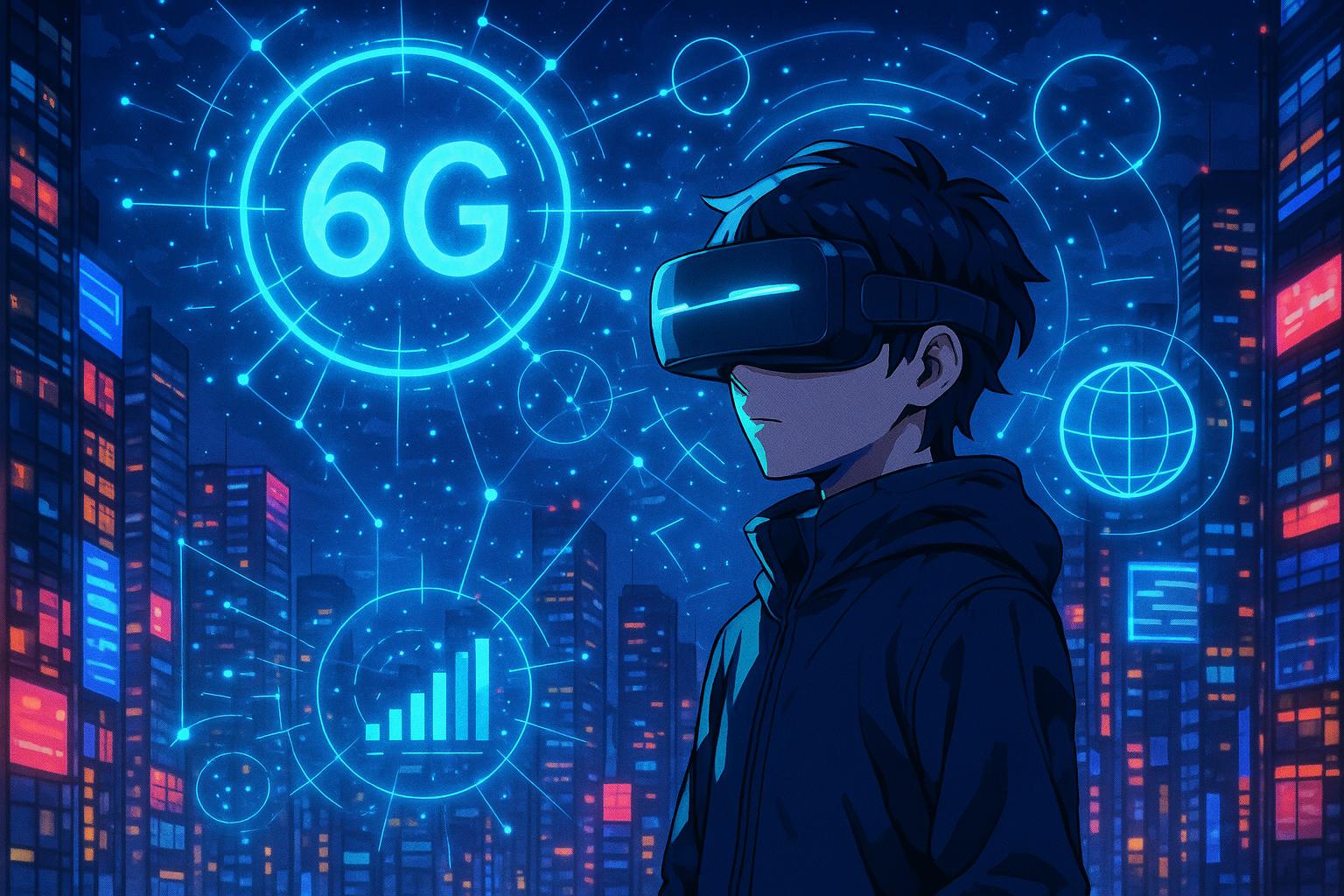A surge in extended reality (XR) content consumption is exposing critical limitations in current wireless infrastructure, prompting calls for revolutionary advances in 5G-Advanced and 6G networks to meet future immersive entertainment and connectivity demands.
As immersive content consumption surges, the demand on existing wireless infrastructure intensifies, necessitating revolutionary advancements in network technology. A recent study by InterDigital, in collaboration with Futuresource Consulting, underscores the critical need for evolution within our wireless networks to accommodate the burgeoning growth of immersive and extended reality (XR) applications. The report, titled “Media over Wireless: Networks for Ubiquitous Video,” paints a vivid picture of how traditional network architectures are ill-equipped to support the next wave of immersive entertainment experiences.
The statistics are compelling. Currently, video traffic constitutes a staggering 69% of all internet data usage, with smartphones alone accounting for 74% of this consumption. This is driven primarily by the proliferation of social media video clips and streaming services that have become ubiquitous in daily life. Notably, a significant portion of global consumers—26%—opt to view subscription video-on-demand services like Netflix and Prime Video on their mobile devices, as contrasted with 41% preferring to watch on television. This trend towards mobile consumption is expected to magnify, particularly within the rapidly growing gaming sector, projected to generate revenues of $85 billion by the end of 2024.
However, the real catalyst for change lies in the anticipated growth of the XR market. By 2031, the number of XR devices shipped globally is expected to quadruple, reaching an estimated 83 million units. Despite this growth potential, the risk of stunted adoption looms large, with 40% of consumers currently expressing dissatisfaction with existing network performance. This underscores an urgent need for significant enhancements in wireless frameworks, especially before the XR market can fully flourish.
Looking towards the future, advancements in 5G-Advanced and the emerging 6G architectures are seen as pivotal in unlocking the potential of XR content. Futuresource anticipates that 6G will likely be deployed in tandem with the maturity of XR hardware and software ecosystems between 2028 and 2032. By 2037, projections indicate that the XR market could encompass around 130 million 6G-enabled devices, positioning XR as the second most significant application category to incorporate 6G capabilities, following smartphones.
As Milind Kulkarni, Head of Wireless Labs at InterDigital, aptly noted, “The high demand for more immersive entertainment cannot be ignored.” He highlighted the transition from merely consuming video to fully engaging with it in interactive environments. This evolvement necessitates a reimagining of wireless systems to manage the intensive throughput and latency demands characteristic of XR applications, which will become increasingly prevalent.
Moreover, technological advancements such as those developed by Nvidia could play a vital role in shaping 6G networks. The company’s recent introduction of an AI-powered cloud-based platform allows for simulation and testing of diverse communications scenarios, involving significant participants like Nokia and Samsung. This collaborative approach indicates a burgeoning synergy between telecom equipment suppliers and technology innovators, which will be crucial for advancing mobile infrastructure.
Ericsson’s insights further illuminate the fundamental developments needed to elevate XR use cases with 6G technology. Their research highlights the importance of optimisation in XR device ecosystems and the integration of communication, computation, and sensing capabilities. The convergence of these domains will enable networks to adapt XR content dynamically to the surrounding physical environments, setting a new standard for interactive experiences.
The global 6G market is projected to experience explosive growth, with forecasts suggesting a rise from USD 4.2 billion in 2022 to USD 68.69 billion by 2035. This expansion will be driven by demands for faster data speeds, reduced latency, and enhanced connectivity, particularly as industries embrace automation and AI-driven applications. With an anticipated compound annual growth rate (CAGR) of 76.9% between 2030 and 2035, the 6G landscape is poised to foster new business models centred around immersive virtual environments and real-time analytics.
As industries transition towards the next generation, the transformative power of 6G will extend beyond entertainment, reshaping sectors such as healthcare, smart cities, and industrial automation. The development of advanced features, including holographic communications, is likely to redefine how we interact with technology. Therefore, as we edge closer to 2030 and the launch of initial 6G standards, it’s evident that immersive experiences will evolve from being a novelty to an expectation.
In summary, the imminent intersection of XR innovations and 6G super-fast connectivity not only heralds a new era of digital engagement but also accentuates the critical need for advanced wireless networks capable of sustaining these advancements. The landscape of entertainment and interactivity is on the brink of a seismic shift, and with it comes the imperative for the telecommunications industry to rise to the occasion.
Reference Map:
- Paragraph 1 – [1], [3]
- Paragraph 2 – [1], [5]
- Paragraph 3 – [2], [6]
- Paragraph 4 – [3], [4]
- Paragraph 5 – [3], [5]
- Paragraph 6 – [4], [6]
- Paragraph 7 – [1], [2]
- Paragraph 8 – [5], [6]
Source: Noah Wire Services
- https://www.thefastmode.com/technology-solutions/42069-xr-growth-pushes-wireless-networks-toward-6g-innovation – Please view link – unable to able to access data
- https://www.reuters.com/technology/nvidia-launches-cloud-based-research-platform-6g-research-testing-2024-03-18/ – Nvidia has introduced an AI-powered cloud-based platform to facilitate research and testing for 6G technology, anticipated to be commercially available by 2030. This platform enables the simulation of varied communications environments, from single cell towers to entire cities, for real-time testing of 6G networks. Among the first users are notable companies such as Ansys, Nokia, Samsung, SoftBank Corp, and Northeastern University. The launch coincided with Nvidia’s global AI conference, boosting technology shares despite a dip in European telecom stocks, with key players like Ericsson and Nokia experiencing declines. This shift indicates that telecom gear suppliers must increasingly collaborate with chipmakers and cloud providers to drive advancements in mobile infrastructure.
- https://www.ericsson.com/en/blog/2023/5/five-research-insights-on-6g-xr – Ericsson discusses the significant advances required across network and application domains to elevate extended reality (XR) with 6G. The company highlights the need for developments in XR device ecosystems, video understanding, and perceptually optimized XR compression. Additionally, it emphasizes the necessity to intersect communication, computation, and sensing capabilities to adapt augmented reality content dynamically to changing physical environments. Future 6G XR will also place entirely new demands on the network in terms of uplink, downlink, latency, and jitter requirements depending on the deployment scenario.
- https://www.globenewswire.com/en/news-release/2024/01/02/2802433/0/en/6G-Technology-Market-Growth-CAGR-27-During-2023-2032-Xcellent-Insights.html – The global 6G technology market was valued at USD 4.2 billion in 2022 and is expected to register a robust compound annual growth rate (CAGR) of 27% during the forecast period. This growth is driven by factors such as rising demand for faster data speeds, lower latency, enhanced security connectivity networks, a high focus on global connectivity and integration, and increasing investments in research and development projects. 6G technology aims to provide faster data speeds, lower latency, and enhanced connectivity compared to existing network connectivity, potentially using terahertz frequencies to achieve ultra-fast speed and data rates, facilitating advanced technologies like augmented reality, virtual reality, and holographic communications.
- https://www.marketsandmarkets.com/PressReleases/6g.asp – According to a research report, the 6G market is expected to reach USD 68.69 billion by 2035 from USD 3.96 billion in 2030, at a compound annual growth rate (CAGR) of 76.9% from 2030–2035. The breakthrough in digital services and connectivity solutions in 6G will open numerous new business models and revenue streams. New business opportunities based on immersive virtual or augmented reality environments, real-time analytics on data, and advances in artificial intelligence-driven services will be enabled. The new revenue sources opened up in the entertainment, healthcare, and smart cities markets will be stimulated by 6G due to growing demands for high-quality interactive applications.
- https://market.us/report/6g-telecom-market/ – The global 6G telecom market size is expected to be worth around USD 693.0 billion by 2033, from USD 42.5 billion in 2023, growing at a compound annual growth rate (CAGR) of 32.2% during the forecast period from 2024 to 2033. 6G telecom represents the next evolution in wireless communications, set to surpass the capabilities of the current 5G technology. This technology aims to provide significantly higher data rates, lower latency, and greater reliability. 6G will likely incorporate advanced features like artificial intelligence to manage network operations and support new applications such as holographic communications and high-precision industrial automation.
- https://www.marketresearchintellect.com/product/6g-wireless-technology-market/ – The 6G wireless technology market size was valued at USD 5.1 billion in 2023 and is expected to reach USD 73.46 billion by 2031, growing at a 34.5% compound annual growth rate (CAGR) from 2024 to 2031. Emerging use cases like holographic communications, extended reality (XR), and smart cities further amplify the market’s trajectory. Continued investments in research and development by major players and government support for next-generation technologies are creating a robust ecosystem for 6G deployment, ensuring its prominence in the global technological landscape. Improvements in telecommunications infrastructure and the growing demand for high-speed connectivity are driving the market for 6G wireless technology, which is expected to grow exponentially as industries shift towards automation, IoT, and AI-driven applications.
Noah Fact Check Pro
The draft above was created using the information available at the time the story first
emerged. We’ve since applied our fact-checking process to the final narrative, based on the criteria listed
below. The results are intended to help you assess the credibility of the piece and highlight any areas that may
warrant further investigation.
Freshness check
Score:
7
Notes:
The narrative references a report titled “Media over Wireless: Networks for Ubiquitous Video” by InterDigital and Futuresource Consulting. However, the exact publication date of this report is not specified in the provided information. The article also mentions Nvidia’s AI-powered cloud-based platform for 6G research, which was launched on March 18, 2024. ([reuters.com](https://www.reuters.com/technology/nvidia-launches-cloud-based-research-platform-6g-research-testing-2024-03-18/?utm_source=openai)) Given that the article was published on June 2, 2025, the information appears to be current, with no evidence of recycled content. The absence of a specific publication date for the InterDigital and Futuresource Consulting report makes it challenging to assess the freshness of that particular source.
Quotes check
Score:
8
Notes:
The article includes a direct quote from Milind Kulkarni, Head of Wireless Labs at InterDigital: “The high demand for more immersive entertainment cannot be ignored.” A search for this exact quote did not yield earlier instances, suggesting it may be original or exclusive content. However, without a specific publication date for the InterDigital and Futuresource Consulting report, it’s difficult to confirm the originality of the quote within that context.
Source reliability
Score:
6
Notes:
The narrative originates from The Fast Mode, a platform that aggregates news and insights related to the telecom industry. While it provides valuable information, its reputation and editorial standards are not as well-established as those of major news outlets. The reliance on a press release from InterDigital and Futuresource Consulting, without a specified publication date, further complicates the assessment of source reliability.
Plausability check
Score:
7
Notes:
The claims regarding the growth of XR applications and the need for advancements in wireless networks to support them are plausible and align with current industry trends. The projected growth of the XR market and the anticipated deployment of 6G technologies between 2028 and 2032 are consistent with other industry forecasts. However, the lack of a specific publication date for the InterDigital and Futuresource Consulting report and the absence of direct citations for some claims reduce the overall credibility of the narrative.
Overall assessment
Verdict (FAIL, OPEN, PASS): OPEN
Confidence (LOW, MEDIUM, HIGH): MEDIUM
Summary:
The narrative presents plausible claims about the growth of XR applications and the need for advancements in wireless networks to support them. However, the lack of a specific publication date for the InterDigital and Futuresource Consulting report, reliance on a press release from InterDigital and Futuresource Consulting, and the absence of direct citations for some claims reduce the overall credibility of the narrative. Therefore, further verification is recommended to confirm the accuracy and originality of the information presented.













